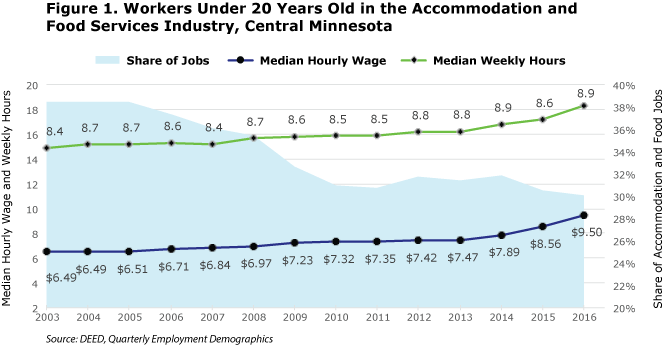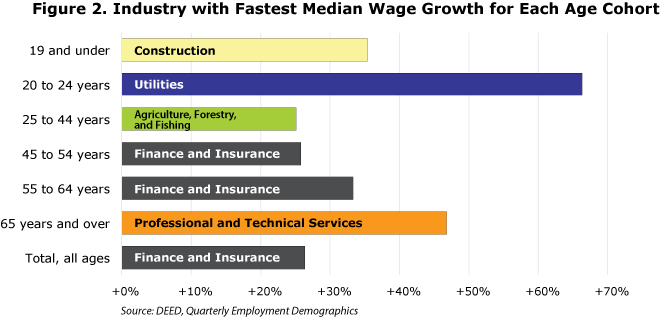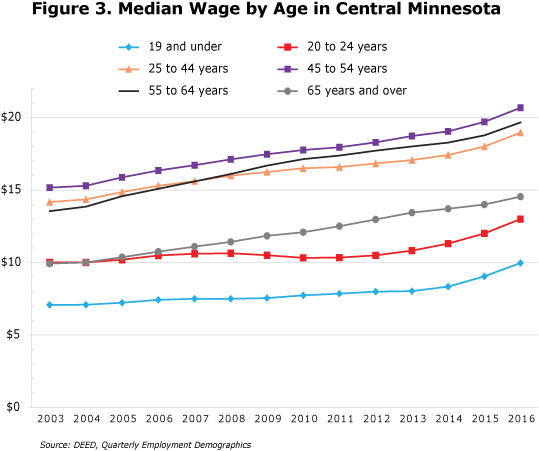by Luke Greiner
November 2017
Young workers and low wages are often synonymous. With little experience and few skills, young workers largely fill entry level jobs. However, not all workers in their teens and early twenties are earning wages near the minimum. Depending on the industry, median hourly wages for young workers can vary significantly. Thanks to new data provided by DEED’s Quarterly Employment Demographics (QED) program, this article will look at how central Minnesota’s economy is responding to shifts in the labor market, particularly for the youngest workers.
After nearly a decade of declining employment, the youngest workers in central Minnesota have begun claiming a larger share of total jobs. In 2003 11.3 percent of jobs in the region were held by workers 19 years and younger. This group, however, was impacted by the recession more than any other age cohort, and by 2011 the percentage had dropped to just 8 percent of total jobs.
An increasing number of jobs are held by workers aged 55 years and older because of the size of that generation in the workforce, which naturally decreases the share that can be held by other cohorts. But the actual number of jobs held by teenagers had been shrinking from 2000 until 2011 as well. Since bottoming out in 2011, the share of teenaged workers has steadily climbed back to 9.1% as of 2016, while the number of jobs held by teenagers also increased for the first time in a decade. Looking closer at the data we can see how central Minnesota industries are being shaped by the ages of their employees.
Quarterly Employment DemographicsDEED’s capacity to communicate detailed labor market data has recently been greatly enhanced by an inter-agency collaboration with the Minnesota Department of Public Safety. The agreement grants DEED access to age and gender data which is then linked to administrative records from Minnesota’s Unemployment Insurance program. The outcome is a brand new and unique dataset spanning back to 2003, with quarterly data on various demographic, regional, and labor force variables. This new dataset will enable the LMI office to bring to stakeholders demographic data on the labor market that previously had only limited availability. The use of this dataset will follow strict codes of confidentiality of information, and only medians will be calculated and published. |
Interestingly, the share of jobs in the Accommodation and Food Services industry held by workers younger than 20 years has been in steady decline, while the share held by prime working age adults (25-54 years) has increased since 2003. Meanwhile, the percentage of Accommodation and Food Services jobs held by 55 to 64 year olds has more than doubled in less than 10 years. Most of the shift that decreased the ratio of younger workers occurred in the Accommodation part of the industry – think hotels rather than restaurants – declining to 9.8 percent for teenaged workers in 2016 from 22.7 percent in 2003.
In step with statewide minimum wage increases in 2014, 2015, and 2016, teenaged workers - the lowest paid workers in the Accommodation and Food Services industry - saw their wages rise faster than any other age cohort. By 2016 the median hourly wage for workers under 20 years reached $9.50, while the median hours worked slowly crept higher since the end of the recession.
While the median weekly hours worked in the Accommodation and Food Services industry is relatively low, the median weekly hours worked for teenagers in all industries was only slightly higher at 10.23 hours in 2016, although that was enough to be the highest on record (see Figure 1).

The Construction industry has the highest median hourly wage for teenaged workers, topping $14.42 per hour, compared to a low of $9.25 for the Arts, Entertainment, and Recreation industry. The demand for labor in the Construction industry has pushed median hourly wages for teenagers in central Minnesota to grow 3.8 times faster than inflation from 2010 to 2016. Following the Construction industry, the next highest median hourly wage for teenaged workers was $12.08 in Manufacturing and $11.20 in the Health Care and Social Assistance industry. Workers under 20 in Construction and Manufacturing have the highest median weekly hours worked at 20.5 and 16 hours, respectively.
Median hourly wages for workers of all ages in central Minnesota grew by 15.2 percent from the end 2010 to 2016, far exceeding the 9.3 percent rate of inflation during that period. Possibly from a combination of regaining employment opportunities that young workers were pushed out of during the recession and substantial increases to the minimum wage, teenaged workers in the region enjoyed the fastest wage growth in general, increasing by 29 percent from 2010 to 2016.
Unlike wage growth for teenagers working in Retail and Accommodation and Food Service, the rise in Construction industry pay was not directly impacted by minimum wage increases. Wages for teenaged workers in the Construction industry was higher than the minimum wage before the recent minimum wage increase and was rising years before the policy became law.
As unemployment rates suspend at historically low levels, competition for labor in central Minnesota is driving wage growth with differing velocities for each age cohort. Aside from differences in median hourly wage growth by age, even larger differences are uncovered when disaggregated by industry sector.
Teenaged workers in the Construction industry have experienced faster wage growth than their peers employed in other industries, with median hourly wages increasing 35 percent from 2010 to 2016. As teenaged workers age into their early twenties, their median hourly wages continue to climb, yet Utilities sets itself apart with median hourly wages for 20 to 24 year olds topping $31.51 in 2016. The lucky few 20 to 24-year-olds working in Utilities hold just 4.6 percent of Utility jobs, and enjoyed the fastest wage growth (66%) from 2010 to 2016 (see Figure 2).

The most obvious change happening in workplaces across the region, state, and country is the aging of “baby boomers” which is creating stress and challenges in the labor market. While conversations around retention of the most veteran employees is warranted, the interaction between age and employment is changing in many other less obvious ways.
A unique pattern that emerged from the recession appears to be a change in the pecking order of workers. When median hourly wages are broken down by age and compared pre-recession to post-recession, data show that wages for older workers steadily increased while young workers saw slower or negative wage growth.
In the years prior to the recession the median hourly wage for workers 20 to 24 and workers 65 years and older was nearly identical, but by 2013 the gap widened, and the older cohort had median hourly wages that were $2.62 higher than the younger cohort. Workers 25 to 44 years also saw slower wage growth than their older counterparts, enough so that by 2008 their median hourly wage was less than it was for workers 55-to-64 years old.
This is likely caused in part by the increasing number of older workers working longer and being retained in higher paid positions pulling the median upwards. Simultaneously turnover rates dropped during the recession, immobilizing the career ladder. Young workers with little experience were competing against more qualified and higher-skilled older workers who were finding fewer opportunities to take different jobs or move up, effectively preventing each younger, lower skilled cohort from moving up. The youngest workers were essentially stuck in entry-level jobs.

Now with the economy recovered, the minimum wage rising, and job openings galore, young workers are enjoying rapid wage increases across almost all industries. So what can young workers in central Minnesota expect in the central Minnesota labor market moving forward?
Fast wage growth. Thanks to high demand for labor, wages are going up across the board with particularly high wage growth in Construction.
A need for patience. Peak earning potential occurred between 45 and 54 years in all but four industries: Accommodation and Food Services, Arts, Entertainment, and Recreation, Professional and Technical Services, and Mining.
Increased opportunities for employment. This may include even more access to higher-paying occupations than previous young workers had. Large numbers of retirements in combination with an increasing need to fill jobs will open doors to young workers with in-demand skills.
For readers interested in more information about wage growth across age groups and industries in Central Minnesota.